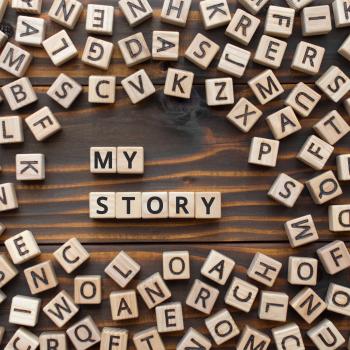Alphabiography Project: Totally You

- Preview |
- Standards |
- Resources & Preparation |
- Instructional Plan |
- Related Resources |
- Comments
Overview
In this lesson plan, the traditional autobiography writing project is given a twist as students write alphabiographies—recording an event, person, object, or feeling associated with each letter of the alphabet. Students are introduced to the idea of the alphabiography through passages from James Howe's Totally Joe. Students then work with the teacher to create guidelines for writing their own alphabiographies. Students create an entry for each letter of the alphabet, writing about an important event from their lives. After the entry for each letter, students sum up the stories and vignettes by recording the life lessons they learned from the events. Since this type of autobiography breaks out of chronological order, students can choose what has been important in their lives. And since the writing pieces are short, even reluctant writers are eager to write!
Featured Resources
Sample Alphabiography Entry: Use this example to guide students in their alphabiography projects.
Alphabet Organizer: Students can use this online tool to publish their alphabiography.
From Theory to Practice
To engage adolescent learners, teachers must create classroom environments that are stimulating, varied, and most importantly, that connect to students' daily lives. The importance of these connections is reiterated in the NCTE Guideline on Adolescent Literacy, which states: "All students need to go beyond the study of discrete skills and strategies to understand how those skills and strategies are integrated with life experiences. Langer, et al. found that literacy programs that successfully teach at-risk students emphasize connections between students' lives, prior knowledge, and texts, and emphasize student conversations to make those connections." This lesson plan invites students to write about what they know-themselves and their lives. In this way, the lesson focuses on the one subject that is most likely to generate successful student engagement and learning.
Further Reading
Common Core Standards
This resource has been aligned to the Common Core State Standards for states in which they have been adopted. If a state does not appear in the drop-down, CCSS alignments are forthcoming.
State Standards
This lesson has been aligned to standards in the following states. If a state does not appear in the drop-down, standard alignments are not currently available for that state.
NCTE/IRA National Standards for the English Language Arts
- 3. Students apply a wide range of strategies to comprehend, interpret, evaluate, and appreciate texts. They draw on their prior experience, their interactions with other readers and writers, their knowledge of word meaning and of other texts, their word identification strategies, and their understanding of textual features (e.g., sound-letter correspondence, sentence structure, context, graphics).
- 4. Students adjust their use of spoken, written, and visual language (e.g., conventions, style, vocabulary) to communicate effectively with a variety of audiences and for different purposes.
- 5. Students employ a wide range of strategies as they write and use different writing process elements appropriately to communicate with different audiences for a variety of purposes.
- 6. Students apply knowledge of language structure, language conventions (e.g., spelling and punctuation), media techniques, figurative language, and genre to create, critique, and discuss print and nonprint texts.
- 11. Students participate as knowledgeable, reflective, creative, and critical members of a variety of literacy communities.
- 12. Students use spoken, written, and visual language to accomplish their own purposes (e.g., for learning, enjoyment, persuasion, and the exchange of information).
Materials and Technology
- Totally Joe by James Howe
- Writing materials, such as a writer’s notebook, pens, pencils, etc.
- Writer’s notebook (optional)
Printouts
Websites
Preparation
- Review the book Totally Joe by James Howe, about a boy named Joe who deals with many adolescent issues—friendships, school, and coming to terms about his homosexuality. The book is a follow-up to Howe’s book The Misfits.
- Decide whether the students will be reading this novel independently, as a read aloud, or in literature circles. This lesson can easily be implemented using one copy of the text as a read aloud. Adjust the lesson plan as needed to match with how the text is shared with the students.
- Make appropriate copies of the Sample Alphabiography Entry and Alphabiography Self-Assessment.
- Test the online Alphabet Organizer on your computers or download the Alphabet Organizer mobile app to familiarize yourself with the tools. For this activity, Option 2 on the Alphabet Organizer is the best choice.
Student Objectives
Students will
- write an autobiography using the letters of the alphabet.
- describe significant life events and interests.
- apply summarizing skills to their entries.
- assess their entries using a checklist.
Session One
- Begin the session by asking students to share what they know about biographies and autobiographies. Try to make connections to any texts that have been covered in class.
- Next, share the word “alphabiography” with the class by writing it on the board or on chart paper. Invite students to share their reactions to the term, encouraging them to break the word into two parts to determine its meaning.
- Follow up the discussion by reading the letter that Joe writes to his teacher Mr. Daly before he shares his alphabiography in Totally Joe.
- After sharing Joe’s letter, tell students that they will also be crafting their own alphabiographies, writing about a person, place, thing, or event for each letter of the alphabet.
- Explain that after the entry, students will sum up the life story by recording life lessons (what they have learned from the experiences). Share details from the last question in the Teaching Tolerance interview with author James Howe, “Totally James,” to provide the author’s commentary on the life lessons in Totally Joe.
- Read a few of Joe’s alphabiography entries with students; or if there are multiple copies of the text available, ask students to choose examples to share with the rest of the class.
- Pass out copies of the Sample Alphabiography Entry, and read the model with the class.
- Discuss the voice and tone of the entries in Howe’s book and the Sample Alphabiography Entry with the class. Note that both authors use very informal style and that this tone and voice is fine for their own writing as well.
- Once students have experience with an alphabiography, work together as a class to discuss what the requirements of the project should be. You can begin the discussion by creating a guideline for the tone and voice of the entries.
- As you create the class list, be sure to answer questions such as “What should be included in each entry?” and “What should we do if they cannot think of anything for a letter of the alphabet?”
- Record the requirements and tips on the board or on chart paper; and use the information to create the students’ self-assessment checklist to be shared at the next session. Alternately, customize the Alphabiography Self-Assessment to incorporate students’ observations and suggestions.
Session Two
- Pass out the self-assessment checklist that students helped to create in the previous session, or pass out your customized version of the Alphabiography Self-Assessment.
- As a class, decide how often assignments will be turned in. Will students turn in a letter or two per week, or wait and turn in the entire project as Joe did?
- Once a deadline has been determined, provide time for the students to write in class and as homework. Students can write their alphabiography in a notebook, or they can use the Alphabet Organizer as a means of publishing. Suggest that students choose Option 2 in the Alphabet Organizer, as it best fits the entries they will compose.
- Remind students that they do not have to write this alphabiography in a linear fashion: A, B, C, and so forth. They can write entries as they think of them and then relate their entries to the appropriate letter of the alphabet.
- In the same vein, students can publish when they have entries done, or when their entire alphabiographies are completed.
Session Three
- When students have completed all entries of their alphabiographies, re-read to the class the letter that Joe writes to his teacher Mr. Daly.
- Ask students to write similar letters to the teacher, which will serve as an introduction to their alphabiographies. For more strategies on composing these letters, explore the Draft Letters: Improving Student Writing through Critical Thinking lesson plan.
- If there are students who would like to share an entry or two from their alphabiographies, allow time for them to do so.
- Provide time for the students to assess their alphabiographies, using the criteria set by the class or using the customized version of the Alphabiography Self-Assessment.
Extensions
- Adapt this strategy as a book report alternative, asking students to write alphabiographies from the point of view of a character in a book they have recently read.
- See the lesson plan activity in “Totally Us,” from Tolerance.org, for additional alternatives for composing alphabiographies with students.
Student Assessment / Reflections
Review the work that students complete during this project on an on-going basis for the thoroughness and completeness. As students work on their entries, talk to them and observe their work. Pay particular attention to the connections they make from their life to their writing. Collect completed self-assessments when collecting the finished alphabiographies, and use the checklist to provide feedback on students’ work. As you review the artifacts, look for evidence that students’ assessment accurately reflects their performance in the alphabiographies. Focus feedback on places where students’ understanding of the requirements seems lacking and/or where their performance does not match the assessment they completed.

I think it's totally appropriate for the classroom and for middle school students and I will be using it soon.
I think it's totally appropriate for the classroom and for middle school students and I will be using it soon.
I think it's totally appropriate for the classroom and for middle school students and I will be using it soon.
Add new comment